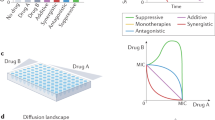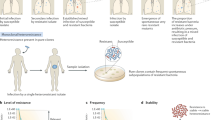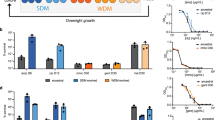Abstract
Bacteria have developed resistance against every antibiotic at a rate that is alarming considering the timescale at which new antibiotics are developed. Thus, there is a critical need to use antibiotics more effectively, extend the shelf life of existing antibiotics and minimize their side effects. This requires understanding the mechanisms underlying bacterial drug responses. Past studies have focused on survival in the presence of antibiotics by individual cells, as genetic mutants or persisters. Also important, however, is the fact that a population of bacterial cells can collectively survive antibiotic treatments lethal to individual cells. This tolerance can arise by diverse mechanisms, including resistance-conferring enzyme production, titration-mediated bistable growth inhibition, swarming and interpopulation interactions. These strategies can enable rapid population recovery after antibiotic treatment and provide a time window during which otherwise susceptible bacteria can acquire inheritable genetic resistance. Here, we emphasize the potential for targeting collective antibiotic tolerance behaviors as an antibacterial treatment strategy.
This is a preview of subscription content, access via your institution
Access options
Subscribe to this journal
Receive 12 print issues and online access
$259.00 per year
only $21.58 per issue
Buy this article
- Purchase on Springer Link
- Instant access to full article PDF
Prices may be subject to local taxes which are calculated during checkout




Similar content being viewed by others
References
Levy, S.B. & Marshall, B. Antibacterial resistance worldwide: causes, challenges and responses. Nat. Med. 10, S122–S129 (2004).
Projan, S.J. Why is big Pharma getting out of antibacterial drug discovery? Curr. Opin. Microbiol. 6, 427–430 (2003).
Fishman, N. Antimicrobial stewardship. Am. J. Infect. Control 34, S55–S63 (2006).
Davies, J. & Davies, D. Origins and evolution of antibiotic resistance. Microbiol. Mol. Biol. Rev. 74, 417–433 (2010).
Tuomanen, E., Durack, D. & Tomasz, A. Antibiotic tolerance among clinical isolates of bacteria. Antimicrob. Agents Chemother. 30, 521–527 (1986).
Lewis, K. Persister cells, dormancy and infectious disease. Nat. Rev. Microbiol. 5, 48–56 (2007).
Johnson, P.J. & Levin, B.R. Pharmacodynamics, population dynamics, and the evolution of persistence in Staphylococcus aureus. PLoS Genet. 9, e1003123 (2013).This study demonstrates that persister formation in Staphylococcus aureus can be modulated by subinhibitory antibiotic concentrations. The authors argue that persistence can arise as the result of replication errors and variation in metabolic activity, as opposed to being an evolved characteristic.
Levin, B.R. & Rozen, D.E. Non-inherited antibiotic resistance. Nat. Rev. Microbiol. 4, 556–562 (2006).
Balaban, N.Q., Merrin, J., Chait, R., Kowalik, L. & Leibler, S. Bacterial persistence as a phenotypic switch. Science 305, 1622–1625 (2004).This study uses microfluidics to examine growth rate differences between persistent and proliferative cells. The authors demonstrate the emergence to two classes of persisters: those that are non-growing at stationary phase, and those that are formed by spontaneous switching from a proliferative state during exponential growth.
Tan, C. et al. The inoculum effect and band-pass bacterial response to periodic antibiotic treatment. Mol. Syst. Biol. 8, 617 (2012).Integrating mathematical modeling and experiments, the authors show that antibiotics that inhibit bacterial replication machinery and induce a heat-shock response can result in density-dependent population survival. Furthermore, they demonstrate that periodic dosing can lead to a bandpass filtering response, wherein populations can survive under intermediate dosing frequencies.
Lee, J.H. & Lee, J. Indole as an intercellular signal in microbial communities. FEMS Microbiol. Rev. 34, 426–444 (2010).
Hu, B., Du, J., Zou, R.-y. & Yuan, Y.-j. An environment-sensitive synthetic microbial ecosystem. PLoS ONE 5, e10619 (2010).This manuscript uses a synthetic system to show how mutualism can result in collective antibiotic tolerance. Individually, the bacterial strains would be sensitive to an antibiotic; when they are together, however, they upregulate each other's antibiotic tolerance mechanisms.
Tanouchi, Y., Lee, A.J., Meredith, H. & You, L. Programmed cell death in bacteria and implications for antibiotic therapy. Trends Microbiol. 21, 265–270 (2013).
Nedelcu, A.M., Driscoll, W.W., Durand, P.M., Herron, M.D. & Rashidi, A. On the paradigm of altruistic suicide in the unicellular world. Evolution 65, 3–20 (2011).
Thomson, K.S. & Moland, E.S. Cefepime, piperacillin-tazobactam, and the inoculum effect in tests with extended-spectrum β-lactamase-producing Enterobacteriaceae. Antimicrob. Agents Chemother. 45, 3548–3554 (2001).This study investigates the efficacy of several β-lactam antibiotics against various extended-spectrum β-lactamase (ESBL)-producing strains. The authors found that higher inocula exhibited at least an eightfold higher MIC for the drugs tested, implying that β-lactamase production can be a mechanism for density-dependent survival.
Sykes, R.B. & Matthew, M. The β-lactamases of gram-negative bacteria and their role in resistance to β-lactam antibiotics. J. Antimicrob. Chemother. 2, 115–157 (1976).
Kolodkin-Gal, I., Sat, B., Keshet, A. & Engelberg-Kulka, H. The communication factor EDF and the toxin–antitoxin module mazEF determine the mode of action of antibiotics. PLoS Biol. 6, e319 (2008).
Engelberg-Kulka, H., Sat, B., Reches, M., Amitai, S. & Hazan, R. Bacterial programmed cell death systems as targets for antibiotics. Trends Microbiol. 12, 66–71 (2004).
McGannon, C.M., Fuller, C.A. & Weiss, A.A. Different classes of antibiotics differentially influence Shiga toxin production. Antimicrob. Agents Chemother. 54, 3790–3798 (2010).
Plunkett, G., Rose, D.J., Durfee, T.J. & Blattner, F.R. Sequence of Shiga toxin 2 phage 933W from Escherichia coli O157: H7: Shiga toxin as a phage late-gene product. J. Bacteriol. 181, 1767–1778 (1999).
Lainhart, W., Stolfa, G. & Koudelka, G.B. Shiga toxin as a bacterial defense against a eukaryotic predator, Tetrahymena thermophila. J. Bacteriol. 191, 5116–5122 (2009).
Miller, M.B. & Bassler, B.L. Quorum sensing in bacteria. Annu. Rev. Microbiol. 55, 165–199 (2001).
Hammer, B.K. & Bassler, B.L. Quorum sensing controls biofilm formation in Vibrio cholerae. Mol. Microbiol. 50, 101–104 (2003).
Pai, A., Tanouchi, Y. & You, L. Optimality and robustness in quorum sensing (QS)-mediated regulation of a costly public good enzyme. Proc. Natl. Acad. Sci. USA 109, 19810–19815 (2012).
Robicsek, A. et al. Fluoroquinolone-modifying enzyme: a new adaptation of a common aminoglycoside acetyltransferase. Nat. Med. 12, 83–88 (2006).
Ding, X., Baca-DeLancey, R.R. & Rather, P.N. Role of SspA in the density-dependent expression of the transcriptional activator AarP in Providencia stuartii. FEMS Microbiol. Lett. 196, 25–29 (2001).
Juhas, M., Eberl, L. & Tümmler, B. Quorum sensing: the power of cooperation in the world of Pseudomonas. Environ. Microbiol. 7, 459–471 (2005).This review discusses the role of quorum sensing in P. aeruginosa virulence, particularly the coupled Las and Rhl motifs. The authors also discuss the potential of interfering with quorum sensing systems as an antimicrobial strategy.
Davies, D.G. et al. The involvement of cell-to-cell signals in the development of a bacterial biofilm. Science 280, 295–298 (1998).
Ishida, H. et al. In vitro and in vivo activities of levofloxacin against biofilm-producing Pseudomonas aeruginosa. Antimicrob. Agents Chemother. 42, 1641–1645 (1998).
Singh, R., Ray, P., Das, A. & Sharma, M. Penetration of antibiotics through Staphylococcus aureus and Staphylococcus epidermidis biofilms. J. Antimicrob. Chemother. 65, 1955–1958 (2010).
Anderl, J.N., Franklin, M.J. & Stewart, P.S. Role of antibiotic penetration limitation in Klebsiella pneumoniae biofilm resistance to ampicillin and ciprofloxacin. Antimicrob. Agents Chemother. 44, 1818–1824 (2000).
Giwercman, B., Jensen, E., Høiby, N., Kharazmi, A. & Costerton, J. Induction of beta-lactamase production in Pseudomonas aeruginosa biofilm. Antimicrob. Agents Chemother. 35, 1008–1010 (1991).
Costerton, J.W., Stewart, P.S. & Greenberg, E. Bacterial biofilms: a common cause of persistent infections. Science 284, 1318–1322 (1999).
Craig, W.A., Bhavnani, S.M. & Ambrose, P.G. The inoculum effect: fact or artifact? Diagn. Microbiol. Infect. Dis. 50, 229–230 (2004).
Udekwu, K.I., Parrish, N., Ankomah, P., Baquero, F. & Levin, B.R. Functional relationship between bacterial cell density and the efficacy of antibiotics. J. Antimicrob. Chemother. 63, 745–757 (2009).
Tadmor, A.D. & Tlusty, T. A coarse-grained biophysical model of E. coli and its application to perturbation of the rRNA operon copy number. PLoS Comput. Biol. 4, e1000038 (2008).
Thron, C. Bistable biochemical switching and the control of the events of the cell cycle. Oncogene 15, 317–325 (1997).
VanBogelen, R.A. & Neidhardt, F.C. Ribosomes as sensors of heat and cold shock in Escherichia coli. Proc. Natl. Acad. Sci. USA 87, 5589–5593 (1990).
Sykes, M.T., Shajani, Z., Sperling, E., Beck, A.H. & Williamson, J.R. Quantitative proteomic analysis of ribosome assembly and turnover in vivo. J. Mol. Biol. 403, 331–345 (2010).
Rice, K.C. et al. The Staphylococcus aureus cidAB operon: evaluation of its role in regulation of murein hydrolase activity and penicillin tolerance. J. Bacteriol. 185, 2635–2643 (2003).
Rice, K.C. et al. The cidA murein hydrolase regulator contributes to DNA release and biofilm development in Staphylococcus aureus. Proc. Natl. Acad. Sci. USA 104, 8113–8118 (2007).
Bayles, K.W. The biological role of death and lysis in biofilm development. Nat. Rev. Microbiol. 5, 721–726 (2007).
Groicher, K.H., Firek, B.A., Fujimoto, D.F. & Bayles, K.W. The Staphylococcus aureus lrgAB operon modulates murein hydrolase activity and penicillin tolerance. J. Bacteriol. 182, 1794–1801 (2000).
Köhler, T., Curty, L.K., Barja, F., van Delden, C. & Pechère, J.-C. Swarming of Pseudomonas aeruginosa is dependent on cell-to-cell signaling and requires flagella and pili. J. Bacteriol. 182, 5990–5996 (2000).
Butler, M.T., Wang, Q. & Harshey, R.M. Cell density and mobility protect swarming bacteria against antibiotics. Proc. Natl. Acad. Sci. USA 107, 3776–3781 (2010).This work shows that a swarming phenotype promotes bacterial survival of antibiotic treatment. The authors demonstrate that this survival advantage is not due to quorum sensing or induced resistance pathways, but rather occurs at a cost to cells directly exposed to antibiotic.
Kim, W., Killam, T., Sood, V. & Surette, M.G. Swarm-cell differentiation in Salmonella enterica serovar Typhimurium results in elevated resistance to multiple antibiotics. J. Bacteriol. 185, 3111–3117 (2003).
Verstraeten, N. et al. Living on a surface: swarming and biofilm formation. Trends Microbiol. 16, 496–506 (2008).
van Ditmarsch, D. et al. Convergent evolution of hyperswarming leads to impaired biofilm formation in pathogenic bacteria. Cell Reports 4, 697–708 (2013).This study shows that a swarming phenotype is inversely correlated with biofilm formation in P. aeruginosa , suggesting an evolutionary tradeoff between these two mechanisms of antibiotic tolerance.
Overhage, J., Bains, M., Brazas, M.D. & Hancock, R.E. Swarming of Pseudomonas aeruginosa is a complex adaptation leading to increased production of virulence factors and antibiotic resistance. J. Bacteriol. 190, 2671–2679 (2008).
Gunn, J.S. Bacterial modification of LPS and resistance to antimicrobial peptides. J. Endotoxin Res. 7, 57–62 (2001).
Lee, H.H., Molla, M.N., Cantor, C.R. & Collins, J.J. Bacterial charity work leads to population-wide resistance. Nature 467, 82–85 (2010).This study demonstrates how collective tolerance can arise in a mixed population. Specifically, a population consisting largely of antibiotic-sensitive bacteria can survive treatment if a fraction of the population is resistant mutants that produce enough signaling molecule for the entire population to increase tolerance.
Andersen, J.B. et al. gfp-based N-acyl homoserine-lactone sensor systems for detection of bacterial communication. Appl. Environ. Microbiol. 67, 575–585 (2001).
Moons, P., Michiels, C.W. & Aertsen, A. Bacterial interactions in biofilms. Crit. Rev. Microbiol. 35, 157–168 (2009).
Allison, D.G. & Matthews, M. Effect of polysaccharide interactions on antibiotic susceptibility of Pseudomonas aeruginosa. J. Appl. Bacteriol. 73, 484–488 (1992).
Kurioka, T., Yunou, Y., Harada, H. & Kita, E. Efficacy of antibiotic therapy for infection with Shiga-like toxin-producing Escherichia coli O157: H7 in mice with protein-calorie malnutrition. Eur. J. Clin. Microbiol. Infect. Dis. 18, 561–571 (1999).
Kumon, H., Ono, N., Iida, M. & Nickel, J.C. Combination effect of fosfomycin and ofloxacin against Pseudomonas aeruginosa growing in a biofilm. Antimicrob. Agents Chemother. 39, 1038–1044 (1995).
Wolcott, R.D. et al. Biofilm maturity studies indicate sharp debridement opens a time-dependent therapeutic window. J. Wound Care 19, 320–328 (2010).
Jacoby, G.A. AmpC β-lactamases. Clin. Microbiol. Rev. 22, 161–182 (2009).
Drawz, S.M. & Bonomo, R.A. Three decades of β-lactamase inhibitors. Clin. Microbiol. Rev. 23, 160–201 (2010).
Chaïbi, E.B., Sirot, D., Paul, G. & Labia, R. Inhibitor-resistant TEM β-lactamases: phenotypic, genetic and biochemical characteristics. J. Antimicrob. Chemother. 43, 447–458 (1999).
Mutschler, H. & Meinhart, A. ɛ/ζ systems: their role in resistance, virulence, and their potential for antibiotic development. J. Mol. Med. 89, 1183–1194 (2011).
Lioy, V.S., Rey, O., Balsa, D., Pellicer, T. & Alonso, J.C. A toxin–antitoxin module as a target for antimicrobial development. Plasmid 63, 31–39 (2010).
Berry, A.M., Lock, R.A., Hansman, D. & Paton, J.C. Contribution of autolysin to virulence of Streptococcus pneumoniae. Infect. Immun. 57, 2324–2330 (1989).
Tanouchi, Y., Pai, A., Buchler, N.E. & You, L. Programming stress-induced altruistic death in engineered bacteria. Mol. Syst. Biol. 8, 626 (2012).This study uses a synthetic system to demonstrate the conditions under which programmed cell death can benefit a population. In particular, a population has to be producing sufficient amounts of a public good (such as β-lactamase) to benefit from lysing; otherwise the population will go extinct.
Tateda, K. et al. Azithromycin inhibits quorum sensing in Pseudomonas aeruginosa. Antimicrob. Agents Chemother. 45, 1930–1933 (2001).
van Delden, C. et al. Azithromycin to prevent Pseudomonas aeruginosa ventilator-associated pneumonia by inhibition of quorum sensing: a randomized controlled trial. Intensive Care Med. 38, 1118–1125 (2012).
Dong, Y.-H., Xu, J.-L., Li, X.-Z. & Zhang, L.-H. AiiA, an enzyme that inactivates the acylhomoserine lactone quorum-sensing signal and attenuates the virulence of Erwinia carotovora. Proc. Natl. Acad. Sci. USA 97, 3526–3531 (2000).
O'Loughlin, C.T. et al. A quorum-sensing inhibitor blocks Pseudomonas aeruginosa virulence and biofilm formation. Proc. Natl. Acad. Sci. USA 110, 17981–17986 (2013).
Brackman, G., Cos, P., Maes, L., Nelis, H.J. & Coenye, T. Quorum sensing inhibitors increase the susceptibility of bacterial biofilms to antibiotics in vitro and in vivo. Antimicrob. Agents Chemother. 55, 2655–2661 (2011).
Soong, G. et al. Bacterial neuraminidase facilitates mucosal infection by participating in biofilm production. J. Clin. Invest. 116, 2297–2305 (2006).
Mehta, R. & Champney, W.S. 30S ribosomal subunit assembly is a target for inhibition by aminoglycosides in Escherichia coli. Antimicrob. Agents Chemother. 46, 1546–1549 (2002).
Maisonneuve, E. & Gerdes, K. Molecular mechanisms underlying bacterial persisters. Cell 157, 539–548 (2014).
Dalebroux, Z.D., Svensson, S.L., Gaynor, E.C. & Swanson, M.S. ppGpp conjures bacterial virulence. Microbiol. Mol. Biol. Rev. 74, 171–199 (2010).
Kohanski, M.A., Dwyer, D.J., Hayete, B., Lawrence, C.A. & Collins, J.J. A common mechanism of cellular death induced by bactericidal antibiotics. Cell 130, 797–810 (2007).
Toguchi, A., Siano, M., Burkart, M. & Harshey, R.M. Genetics of swarming motility in Salmonella enterica serovar Typhimurium: critical role for lipopolysaccharide. J. Bacteriol. 182, 6308–6321 (2000).
Mireles, J.R., Toguchi, A. & Harshey, R.M. Salmonella enterica serovar typhimurium swarming mutants with altered biofilm-forming abilities: surfactin inhibits biofilm formation. J. Bacteriol. 183, 5848–5854 (2001).
Brook, I., Pazzaglia, G., Coolbaugh, J.C. & Walker, R.I. In-vivo protection of group A β-haemolytic streptococci from penicillin by β-lactamase-producing Bacteroides species. J. Antimicrob. Chemother. 12, 599–606 (1983).
Citorik, R.J., Mimee, M. & Lu, T.K. Sequence-specific antimicrobials using efficiently delivered RNA-guided nucleases. Nat. Biotechnol. 32, 1141–1145 (2014).
Bikard, D. et al. Exploiting CRISPR-Cas nucleases to produce sequence-specific antimicrobials. Nat. Biotechnol. 32, 1146–1150 (2014).
Eagle, H. & Musselman, A.D. The rate of bactericidal action of penicillin in vitro as a function of its concentration, and its paradoxically reduced activity at high concentrations against certain organisms. J. Exp. Med. 88, 99–131 (1948).
Hentzer, M. et al. Attenuation of Pseudomonas aeruginosa virulence by quorum sensing inhibitors. EMBO J. 22, 3803–3815 (2003).
Hentzer, M. & Givskov, M. Pharmacological inhibition of quorum sensing for the treatment of chronic bacterial infections. J. Clin. Invest. 112, 1300–1307 (2003).
Köhler, T., Perron, G.G., Buckling, A. & Van Delden, C. Quorum sensing inhibition selects for virulence and cooperation in Pseudomonas aeruginosa. PLoS Pathog. 6, e1000883 (2010).This work presents clinical evidence that inhibiting quorum sensing counterintuitively selects for virulent pathogens in the long term.
Nalca, Y. et al. Quorum-sensing antagonistic activities of azithromycin in Pseudomonas aeruginosa PAO1: a global approach. Antimicrob. Agents Chemother. 50, 1680–1688 (2006).
Schuster, M., Joseph Sexton, D., Diggle, S.P. & Peter Greenberg, E. Acyl-homoserine lactone quorum sensing: from evolution to application. Annu. Rev. Microbiol. 67, 43–63 (2013).
Sandoz, K.M., Mitzimberg, S.M. & Schuster, M. Social cheating in Pseudomonas aeruginosa quorum sensing. Proc. Natl. Acad. Sci. USA 104, 15876–15881 (2007).
André, J.B. & Godelle, B. Multicellular organization in bacteria as a target for drug therapy. Ecol. Lett. 8, 800–810 (2005).
Dandekar, A.A., Chugani, S. & Greenberg, E.P. Bacterial quorum sensing and metabolic incentives to cooperate. Science 338, 264–266 (2012).
Chuang, J.S., Rivoire, O. & Leibler, S. Simpson's paradox in a synthetic microbial system. Science 323, 272–275 (2009).
Tanouchi, Y., Smith, R.P. & You, L. Engineering microbial systems to explore ecological and evolutionary dynamics. Curr. Opin. Biotechnol. 23, 791–797 (2012).
Darch, S.E., West, S.A., Winzer, K. & Diggle, S.P. Density-dependent fitness benefits in quorum-sensing bacterial populations. Proc. Natl. Acad. Sci. USA 109, 8259–8263 (2012).
Yurtsev, E.A., Chao, H.X., Datta, M.S., Artemova, T. & Gore, J. Bacterial cheating drives the population dynamics of cooperative antibiotic resistance plasmids. Mol. Syst. Biol. 9, 300–308 (2013).
Allen, R.C., Popat, R., Diggle, S.P. & Brown, S.P. Targeting virulence: can we make evolution-proof drugs? Nat. Rev. Microbiol. 12, 300–308 (2014).
Acknowledgements
Research in our lab related to the topic of this article is in part funded by the US National Institutes of Health, National Science Foundation and Army Research Office and by the David and Lucile Packard Foundation. H.R.M. acknowledges the National Science Foundation Graduate Research Fellowship Program; J.K.S. acknowledges a Duke Center for Biomolecular and Tissue Engineering graduate fellowship; and A.J. Lopatkin acknowledges the Howard G. Clark fellowship.
Author information
Authors and Affiliations
Corresponding author
Ethics declarations
Competing interests
The authors declare no competing financial interests.
Rights and permissions
About this article
Cite this article
Meredith, H., Srimani, J., Lee, A. et al. Collective antibiotic tolerance: mechanisms, dynamics and intervention. Nat Chem Biol 11, 182–188 (2015). https://doi.org/10.1038/nchembio.1754
Received:
Accepted:
Published:
Issue Date:
DOI: https://doi.org/10.1038/nchembio.1754
This article is cited by
-
Reduced selection for antibiotic resistance in community context is maintained despite pressure by additional antibiotics
ISME Communications (2023)
-
Wet-dry cycles protect surface-colonizing bacteria from major antibiotic classes
The ISME Journal (2022)
-
Inoculum effect of Enterobacterales co-expressing OXA-48 and CTX-M on the susceptibility to ceftazidime/avibactam and meropenem
European Journal of Clinical Microbiology & Infectious Diseases (2022)
-
Antibiotic residues in environment: antimicrobial resistance development, ecological risks, and bioremediation
Environmental Science and Pollution Research (2022)
-
Spatial segregation and cooperation in radially expanding microbial colonies under antibiotic stress
The ISME Journal (2021)



